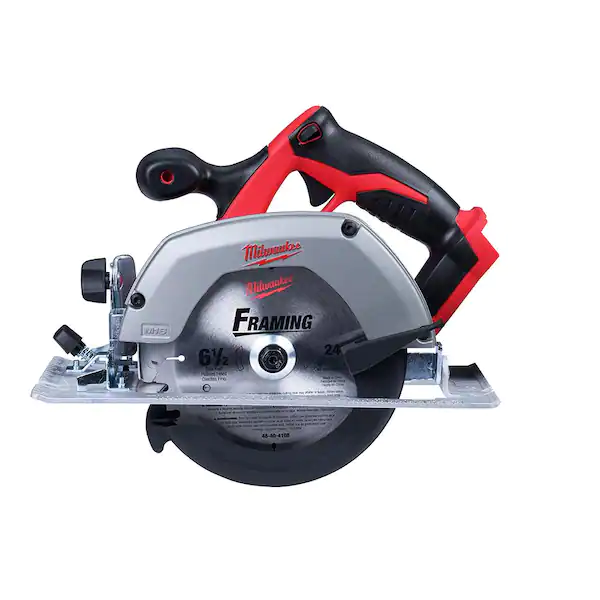
Milwaukee® is a leading manufacturer of power tools, and their circular saws are highly regarded for their quality, durability, and performance. Whether you’re a professional contractor, a DIY enthusiast, or somewhere in between, there’s a Milwaukee circular saw to suit your needs.
Corded vs. Cordless Milwaukee Circular Saws
One of the first decisions you’ll need to make is whether to choose a corded or cordless circular saw.
Corded circular saws:
- Pros: More powerful, generally less expensive, consistent power delivery
- Cons: Tethered to an outlet, less portable
Cordless circular saws:
- Pros: Greater portability, convenient for use outdoors or away from outlets
- Cons: Less powerful than corded models, battery life can be limited, require additional investment in batteries and chargers
Types of Milwaukee Circular Saws
Once you’ve decided on corded or cordless, you’ll need to consider the different types of Milwaukee circular saws available:
- Worm drive saws: Offer high torque for cutting thick materials like lumber and plywood. Popular for framing and construction applications.
- Sidewinder saws: More lightweight and compact than worm drive saws. Good for general-purpose cutting tasks like ripping lumber and plywood.
- Left-handed circular saws: Designed specifically for left-handed users, with blade placement and controls optimized for comfortable use.
Popular Milwaukee Circular Saw Models
Here’s a closer look at some of the most popular Milwaukee circular saw models:
- M18 FUEL™ 7-1/4″ Circular Saw (2732-20): A top-of-the-line cordless saw with brushless motor technology, delivering corded-like power and cutting up to 750 cuts per charge.
- M18 FUEL™ 6-1/2″ Circular Saw (2730-20): Another cordless option, slightly more compact and lighter than the 7-1/4″ model, with comparable power and performance.
- M18 Cordless Lithium-Ion 6-1/2″ Circular Saw (2630-20): A more affordable cordless saw with a brushed motor, still offering good power and durability for general-purpose cutting.
- M12 FUEL™ 6-1/2″ Circular Saw (3401-20): A compact and lightweight cordless saw powered by Milwaukee’s M12™ battery platform, ideal for small projects and tight spaces.
- 5377-21 AC 7-1/4″ Circular Saw: A corded circular saw with a powerful 15 amp motor, designed for demanding professional applications.
Key Features to Consider
When choosing a Milwaukee circular saw, consider the following features:
- Blade diameter: 6-1/2″ or 7-1/4″ are the most common sizes, with larger blades offering greater cutting depth.
- Motor type: Brushless motors provide higher efficiency and longer lifespan than brushed motors.
- Power source: Corded saws offer continuous power, while cordless saws offer portability and convenience.
- Battery platform: If you choose a cordless saw, consider the battery platform and ensure compatibility with other Milwaukee tools you own.
- Dust collection: Some models have built-in dust collection systems to help keep your workspace clean.
- Laser guidance: A laser guide can help you make precise and accurate cuts.
- Warranty: Milwaukee offers a limited warranty on all their circular saws.
Conclusion
Milwaukee circular saws are a reliable and versatile choice for a variety of cutting tasks. By considering your needs and budget, you can find the perfect saw to get the job done.
Milwaukee Circular Saw FAQs:
General:
- What are the benefits of choosing a Milwaukee circular saw?
- Milwaukee saws are known for their quality, durability, and performance.
- They offer a wide variety of models to suit different needs and budgets.
- Both corded and cordless options are available, providing flexibility.
- What warranty does Milwaukee offer on their circular saws?
- Milwaukee offers a limited warranty on all their circular saws, the duration varying depending on the model.
Choosing a Saw:
- Corded vs. cordless: Which is right for me?
- Corded: Ideal for demanding tasks with consistent power delivery, but less portable.
- Cordless: Offers portability and convenience, but has limitations in power and battery life.
- Worm drive vs. sidewinder: What’s the difference?
- Worm drive: High torque for thick materials, popular for framing and construction.
- Sidewinder: Lighter and more compact, good for general-purpose cuts.
- What blade size should I choose?
- 6-1/2″ and 7-1/4″ are the most common sizes, with larger blades offering greater cutting depth.
Features:
- Do I need a brushless motor?
- Brushless motors offer higher efficiency and longer lifespan than brushed motors, but also come at a higher price point.
- Is dust collection important?
- Built-in dust collection helps keep your workspace clean, especially important for indoor projects.
- How important is a laser guide?
- A laser guide can be helpful for making precise and accurate cuts, but may not be essential for all users.
Specific Models:
- What are the differences between the M18 FUEL™ 7-1/4″ and 6-1/2″ circular saws?
- The 7-1/4″ model offers more power and cutting depth, while the 6-1/2″ model is more compact and lightweight.
- Is the M12 FUEL™ 6-1/2″ Circular Saw powerful enough for my needs?
- This compact saw is ideal for small projects and tight spaces, but may not be suitable for demanding tasks.
- How does the 5377-21 AC compare to cordless models?
- This corded saw offers continuous power and durability, but lacks the portability of cordless options.
